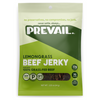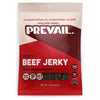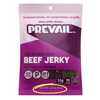Grass-Fed Beef Vs. Grain-Fed Beef (Which Is Better?)

There's something about beef jerky that just gets your mouth watering. The savory, salty, and smoky flavor makes it the perfect snack to keep in your bag for when you're on the go.
But what if we told you that not all beef jerky is created equal? In fact, a good amount of beef jerky products available today are made from grain-fed beef, which isn't as nutrient-rich or delicious as grass-fed beef.
So what is grass-fed beef, and why should you care? In this article, we will discuss the significant differences between Grass-fed and Grain-fed Beef to help you understand why the former is better.
What Is Grass-Fed Beef?
Grass-fed beef is meat from cows that spend their entire lives eating grass. Grass-fed cows typically live on family farms or open pasture land where they roam freely and eat grass that is available to them. This results in leaner and more flavorful meat.
What Is Grain-Fed Beef?

Grain-fed beef (Also known as feedlot beef) is the finished product from cattle that were only fed grains during their lifetime. Grain-fed cattle are best known for eating grains and other grain byproducts such as soy, protein supplements, and beef tallow from close abattoirs and slaughterhouses. The objective is to make these cows gain weight quickly and produce more meat.
While conventional grain-fed beef has been the norm in the United States for many years, grass-fed beef production has recently seen a surge in popularity. This is due to the growing awareness of the health benefits of grass-fed beef and the ethical concerns about how grain-fed cattle are raised.
History Of The Beef Industry
The beef industry has a long history of feeding cattle grain. Grain-fed beef was first introduced in the United States in the mid-1800s- at that time, grass was the primary food source for cattle.
The only grains they consumed back then were tiny grass seeds, making the cow growth rate very 'natural.' However, this changed with the emergence of combine harvesters and a growing beef industry which rewarded cattle producers based on a faster weight gain.
Combines allowed vast quantities of oats, corns, wheat, and other grains to become readily available to conventional beef producers at a relatively cheap cost.
Also, with the development of the railroads, it became possible to transport grain from the Midwest to feedlots in the East. This made it possible to fatten cattle on grain much faster than on grass. As a result, grain-fed beef became the norm in the United States by the early 1900s.
This industrial paradigm shift brought a fresh set of beef industry practices and production. For faster early growth, calves were injected with growth hormones and switched from their natural diet.
Differences Between Grass-Fed Beef And Grain-Fed Beef

Here are some key differences between grass-fed and grain:
Fatty Acid Compositions
Grass-fed beef is higher in Omega-3 fatty acids and CLA (conjugated linoleic acid). On the other hand, grain-fed beef is higher in saturated fat and usually contains a lot more calories per pound of meat.
Nutritional Value
Grass-fed beef contains Vitamin A and E, which are antioxidants that help to protect cells from damage. Asides from that, grass-fed beef possesses Vitamin B12, B3, and B17, which are essential for heart health and energy production.
Grass-fed beef also contains minerals such as potassium, calcium, iron, and zinc than grain-fed beef. And even though grain-fed cows are often engineered to possess more vitamins, they are typically less fortified than their grass-fed counterparts.
Taste And Texture
Grass-fed beef has a more intense flavor than grain-fed beef. Grass-fed beef also tends to be leaner because the cattle have exercised more and have denser muscle composition. Grass-fed beef might taste like wild game, while grain-fed beef has a more "processed" flavor.
Benefits Of Grass-fed Beef

Now that you know the differences between Grass-fed and Grain-fed beef, let's look at the benefits of Grass-fed beef:
Less Fat And Fewer Calories
Your fat and calorie intake are crucial factors to consider in your diet. Grass-fed beef contains less fat and fewer calories than grain-fed beef.
Helps Fight Cancer
Beef from grass-fed cattle has twice the amount of conjugated linoleic acid (CLA) as beef from grain-fed cattle. The majority of naturally occurring antioxidants found in plants are plant-based, but CLA is one of the few anti-cancer elements available in meat.
Reduce Heart Diseases
Grass-fed beef can help reduce heart disease risk because it contains less cholesterol and saturated fats than conventionally raised beef. This is especially important if your family has a history of heart disease.
High-Quality Beef Protein
Grass-fed beef is an excellent source of high-quality protein. It contains all the essential amino acids our body needs to build and repair muscle tissue. Grass-fed beef is also rich in branched-chain amino acids (BCAAs), which are vital for muscle growth and recovery.
Friendly Environmental Impact
Grass-fed beef is more environmentally sustainable than grain-fed beef. Grass-fed cows emit fewer greenhouse gases and require less water and land than grain-fed cattle. Grass-fed cattle are also generally fed on open pastures, while grain-fed cattle are typically confined to concentrated animal feeding operations known as feedlots. Feedlots are generally overcrowded and have poor living conditions.
No Antibiotics And Growth Hormones
Grass-fed beef doesn't contain antibiotics or growth hormones. Antibiotics are often given to grain-fed cattle to prevent them from getting sick because of the unsanitary conditions they live in. Growth hormones are also given to grain-fed cattle to make them grow faster.
Contains Less Bacteria
According to several studies, conventionally raised beef is more prone to include germs than grass-fed beef. One of the most comprehensive investigations ever undertaken by Consumer Reports looked at 300 packages of beef. The researchers discovered antibiotic-resistant staphylococcus aureus (MRSA) in three of the grain-fed samples and none of the grass-finished products.
Additionally, 18% of the non-grass-fed beef samples also tested positive for superbugs, compared to only 9% of grass-fed livestock samples. Superbugs are extremely rare, but they can result in food poisoning if not avoided.
Contains More Electrolytes
One of the benefits of grass-fed beef that often gets overlooked is that it contains electrolytes. Electrolytes are minerals that dissolve in water and help regulate the body's fluid levels.
They are essential for proper muscle function and hydration. Grass-fed beef is a good source of potassium, magnesium, and sodium, which are all electrolytes. Grass-fed beef is also a good source of chloride, which is another electrolyte that helps regulate the body's fluid levels.
What Is GMO Beef?
GMO beef is beef that comes from cattle that have been genetically modified or fed modified grains. GMO foods have been linked with various health risks, such as cancer and infertility.
Grass-fed beef is a better option than GMO beef because it is organic in the sense that it is usually produced or raised on a farm that doesn't use harmful pesticides, genetic engineering (GMOs), or sewer sludge.
Where To Get High-Quality Grass-fed Beef

If you've been searching for where to get grass-fed beef jerky, you've come to the right place. Prevail jerky is a family-owned beef jerky company that offers the highest quality Grass-fed beef jerky available in the market!
We understand how critical it is to guarantee that your family only consumes the purest, healthiest, and most nutritious snacks free of GMOs. This is why all our products undergo a rigorous HACCP cleanup to ensure that there is no cross-contamination.
Regulators are always on the premises to ensure that high standards are maintained. We're also Paleo Certified, which means the Paleo Foundation examines our sourcing procedures to ensure our jerky contains no grains, soy, gluten, or dairy.
All of our beef is from a co-op of Family Farms in New Zealand, where the climate is ideal all year round, and the cattle are raised in ideal conditions. They are healthy, happy, and therefore don't require any antibiotics or hormones.
Finally, we offer various Grass-fed beef jerky flavors that are sure to satisfy your taste buds. Click here to shop now!
Conclusion
Although Grass-fed cattle has been the conventional source of beef for most Americans throughout the years, Grain-fed beef is slowly but surely taking over the market. Grass-fed beef is a healthier, more humane, and environmentally friendly option than grain-fed beef.
And remember, if you are looking for the best place to find grass-fed beef jerky, look no further than Prevail Jerky. We offer the highest quality Grass-fed beef jerky available in the market!
Have you ever tried Grass-fed beef? What did you think? Let us know in the comments below!











